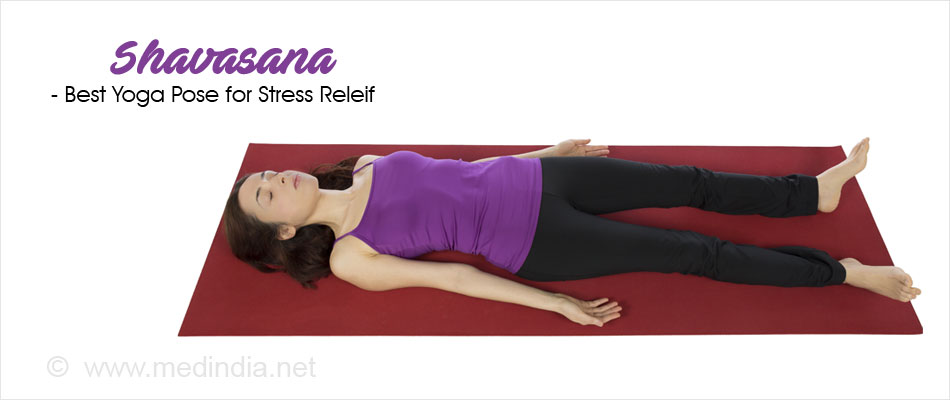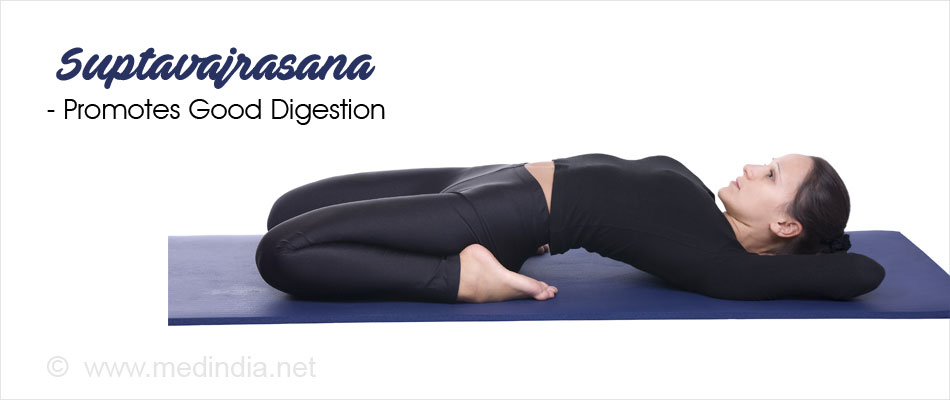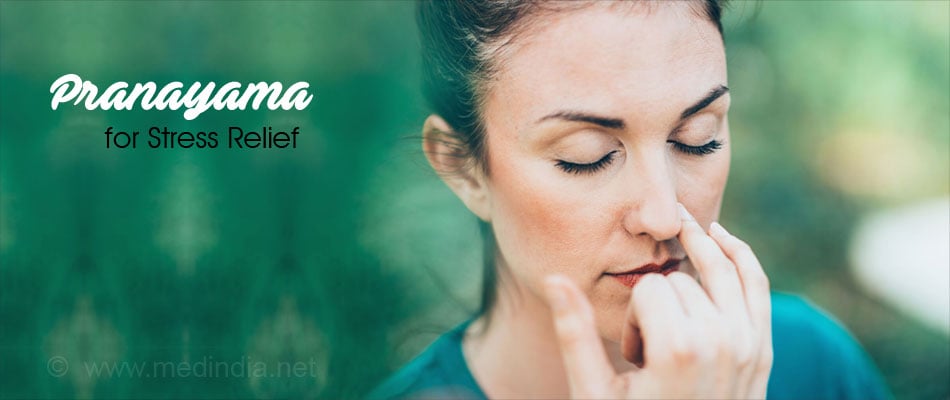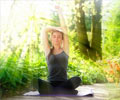- Nadi Shodhana - The sweet breath - (http://www.yogasite.com/nadi.htm)
- Supta-Vajrasana - (http://www.asana-posture.in/supta_vajrasana.htm)
Yoga for Stress
Stress is too subjective a phenomenon to be defined in one particular way. It is difficult to measure and it can affect each person very differently. What can be stressful for you, can be enjoyable to others.
The term ‘stress’ was coined by Hans Selye and he defined it as ‘the non-specific response of the body to any demand for change’ which involves physical, mental or emotional strain and tension.
Just as the definition varies from person to person, so does its symptoms or ‘effects’. Some may experience effects of stress as stiffness of neck, chest pain, headache, or acidity, while others can have stress symptoms such as ulcer or even heart attack!
On an emotional level, you may feel insecure or angry or sad when you are stressed. Stress can affect your behavior too. Eating disorder is a very common stress effect. Some people may take to drugs, alcohol or smoking. Social withdrawal and crying spells are also common behavioral symptoms of stress.
The ancient Indian system of healing considers the solar plexus chakra (or the Manipura) to be associated with stress. This chakra is located below the diaphragm, between the navel and the base of the sternum. It energizes the spleen, pancreas, and stomach and is also associated with heart, lungs and kidneys. Prolonged stress de-vitalizes and blocks this chakra causing it to malfunction and this weakened ‘energy body’ manifests itself as ulcer or palpitations which may lead to number of diseases.
Yoga and breathing techniques help ‘unblock’ the Manipura chakra and make you feel de-stressed and relaxed. Yoga for stress management includes yoga exercises or yoga poses that target specific areas of tension such as the nape of the neck and shoulders or just relaxes you by calming your mind.
Don’t worry if you are new to yoga and want to take up yoga for stress relief. Yoga for beginners includes very simple yoga poses that won’t take you long to learn and master. But remember, every yoga exercise is associated with the right breathing technique.
Shavasana or the corpse pose, bhujangasana or the cobra pose, shalabhasana, suptavajrasana and pranayama are a few yoga poses for stress relief outlined here.

Yoga Poses for Stress Relief
Shavasana or the Corpse pose: It is one of the best yoga poses for stress relief.
- Lie down face up on the yoga mat in a warm room.
- Place your feet about 20 inches apart and loosen (relax) the ankles and toes so that they point outwards naturally.
- Place the hands palm up about 10 inches away from the body.
- Ensure that your shoulder blades are pulled down and the small of your back is relaxed into the floor.
- Completely relax the body so that eventually you’ll forget its there. Focus on your breath. Breathe normally. Notice the subtle movements of breathing.
- Feel yourself in tune with the rhythms of the body. Detach yourself from your thoughts. Let go.
- Do not let your mind wander. Otherwise it’ll beat the purpose of shavasana. The mind should be as much as at rest as the body.
- Come out of shavasana very slowly so as to keep base with the tranquil and relaxed feelings inside of you.

Bhujangasana or the Cobra pose: Bhujangasana pose resembles the raised hood of the snake, hence the name. This is one of the better known exercises for stress relief and reducing fatigue.
- Lie down on your stomach on the yoga mat.
- Put your legs together. Stretch your legs back with the toes stretched outward.
- Bend the elbows and keep your hands with palms down so that your thumb touches the side of the chest.
- Keep your face down till your chin touches the ground softly. Gaze normally.
- Keep the pubis firmly pressed into the mat.
- While inhaling slowly, raise your chin, move your head backward to its limit, and raise your trunk keeping the pubis firmly pressed to the ground.
- Draw your chest forward enough by pulling back your shoulders. Divide your weight between the arms and the spine.
- Don’t flare the elbows or the shoulders will hunch.
- Breathe normally. Hold the pose for 15 to 30 seconds.
- While exhaling, lower your body into the original position – first the trunk, then the shoulders, chin and forehead in that order.
- Remember to raise your trunk smoothly and slowly. Raising the trunk with a jerk can injure the vertebral column.
Shalabhasana or the Locust pose: While bhujangasana stimulates and relaxes the upper part of the body, shalabhasana stimulates the lower part of the body.
- Lie down on your stomach with your face down, chin resting lightly on the ground.
- Put your legs together. Stretch your legs back with the toes stretched outward.
- Keep the pubis firmly pressed into the mat.
- Keep your arms stretched back with palms up. Be relaxed.
- Now clench your hands to form fists, stiffen your knees, legs and arms.
- Inhale slowly, putting slight pressure on your balled fists, lift your legs together (one at a time if you are doing ‘ardha’ shalabhasana and both legs together if you are doing ‘purna’ shalabhasana). Take care to lift them as high as you can without bending your legs.
- Maintain this position for 15 to 30 seconds and hold your breath for as long as you are comfortable.
- Exhale slowly while gently lowering your legs.
- In addition to stress relief, this asana helps strengthen the muscles of abdomen and legs.
Suptavajrasana: Suptavajrasana is a modified Vajrasana or the thunderbolt pose that promotes good digestion. Supta means sleeping or lying down. Vajrasana is one of the basic poses that is used while doing pranayama and meditation.
- Sit on your heels with your body upright and place your hands with palms down on the knees.
- Draw in your stomach and push your chest forward.
- Breathe deeply.
- This is the Vajrasana or the thunderbolt pose.
- Now, slowly bend back, pushing back your hands as you bend and touch the ground with your elbows for support.
- Continue bending till your head touches the ground. You’ll form an arch.
- Breathe deeply and slowly.
- Shut out the world and relax. Maintain this position for 15 to 30 seconds or even a minute if you are comfortable.
- Gently return to the Vajrasana position. Use your elbows to help you up.
Straighten your legs only after you come back to the original Vajrasana position or you might hurt your knees.
Do not try these yoga poses if you suffer from problems of the spine, sciatica, or knee problems.
Practice these yoga poses under the guidance of an expert teacher if you are a beginner. Once you are comfortable with these poses, you won’t need the help of a teacher.
Always consult your doctor before starting on any yoga exercise.

Pranayama for Stress Relief
Pranayama is the fourth limb of the Raja Yoga mentioned in the Yogasutras of Patanjali. Prana means life force or vital energy or simply the breath; yama means control. Thus, Pranayama means control of the life force. Paramahansa Yogananda said, “Yoga works primarily with the energy in the body through the science of pranayama”. Since breath is the fundamental to life, pranayama or the breathing technique is the yogic art of breathing and it is basic to any yoga exercise.
You’ll find that just doing pranayama can help you relax and reduce stress. The breathing technique in pranayama is simple and not very difficult to master. However, you need to keep the following in your mind before starting on pranayama.
- Pranayama is a breathing technique. Be aware of your breathing.
- The breathing process has to be very gentle and even. Jerky or irregular breathing can harm you. Uneven breathing is supposed to be a sign of illness.
- Pranayama is best practiced in the morning when your stomach is empty.
- Practice pranayama in a place free from pollution. Fresh, clean air is very important.
- Practice pranayama under the guidance of an expert teacher if you are a beginner.
- Do not over exert. Pranayama should not make you tired. Rather, it should help you relax and energize you.
Please note: Do not attempt pranayama if you have chronic shortness of breath or any other breathing problems.
Pranayama is all about inhalation, exhalation, and retention of breath. There are many types of pranayama that goes with different sets of yoga.

Nadi Shodhana is the most commonly practiced pranayama for stress relief. This breathing technique involves inhaling through the left nostril and exhaling through the right; then inhaling through the right nostril and exhaling through the left.
- Curl your index finger and middle finger of the right hand. You need to use only the thumb and the ring finger for this breathing technique.
- Close the left nostril by pressing gently with the ring finger.
- Inhale deeply, slowly and steadily through the right nostril.
- Hold the breath inside for a few seconds.
- Now close the right nostril with your thumb and open your left nostril by relaxing your ring finger. Exhale slowly and steadily.
- Repeat this process with the left nostril.
- This will complete one round of nadi shodhana.
- If you are a beginner, do 10-15 rounds of this pranayama. Increase the rounds as you become seasoned.









